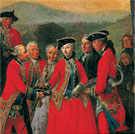
Plate 35
|

Plate 35a
|
|
Banding Birds in the 1700s
Art
The brass band in the hat depicted here reads “1764,” and it will encircle the leg of the Gray Heron (Ardea cinerea), the European form of North America’s Great Blue Heron (A. herodias). Although this painting was produced more than a century after the oldest metal banding recorded —an event that occurred in France, around 1595, when one of Henry IV’s Peregrine Falcons was recovered 1,350 miles (2,170 kilometers) away from where it had been banded— it predates widespread banding escorts, and the novelty of its subject matter may have generated considerable interest. Today it generates interest and some mystery. It serves as the frontispiece for Bird Trapping and Bird Banding, by Hans Bub, but escorts to identify the artist and the current copyright holder have failed.
The modern banding of birds dates back to the success in 1710, when a Gray Heron bearing several bands—one from Turkey, more than 1,200 miles (1,900 kilometers) away—was recovered by a falconer in Germany. Eighteen years later, in 1728, the band that Duke Ferdinand had wrapped around the leg of a bird back in 1669 or so was recovered. In North America the first known banding occurred in 1803. The next year John James Audubon found
page 2--> |

